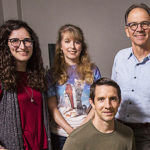Author
Team seeks to create gene expression map of worm’s nervous system
Dec. 12, 2018—by Leigh MacMillan How do you build a brain? What “rules” govern where neurons end up, how they connect to each other, and which functions they perform? “Most of the information that you need to create this extraordinarily complex network of connected cells — the brain — is genetically encoded. The overall architecture is a...
Analyzing single-cell landscapes
Dec. 12, 2018—Nov. 29, 2018, 11:00 AM by Leigh MacMillan Single-cell RNA sequencing is a powerful tool for studying cellular diversity, for example in cancer where varied tumor cell types determine diagnosis, prognosis and response to therapy. Single-cell technologies generate hundreds to thousands of data points per sample, generating a need for new methods to define cell...
Andrea Page-McCaw Elected AAAS Fellow
Nov. 29, 2018—Five Vanderbilt University faculty members have been elected fellows of the American Association for the Advancement of Science this year. They are among 416 fellows from around the country selected by their peers for membership in the world’s largest general scientific society “because of their scientifically or socially distinguished efforts to advance science or its applications.” Vanderbilt...
Evading cell death
Nov. 28, 2018—Nov. 8, 2018, 1:30 PM by Amanda Johnson Cancer cells can develop resistance to the treatments designed to eliminate them. Several studies have linked stress granules (SGs), cell organelles that form transiently in response to extracellular stress, to this phenomenon. However, how SGs protect cancer cells remains unclear. Susan Wente, PhD, and Laura Glass, PhD, report...
Nilay Taneja received 11th place at the Nikon Small World Photomicrography contest
Oct. 22, 2018—Nilay Taneja (Burnette Lab) recently received 11th place at the Nikon Small World Photomicrography contest for his submission, “Human fibroblast undergoing cell division, showing actin (gray), myosin II (green) and DNA (magenta),” using structured illumination microscopy at Vanderbilt’s Nikon Center of Excellence facility.
Novel genetic study sheds new light on risk of heart attack
Oct. 22, 2018—Loss of a protein that regulates mitochondrial function can greatly increase the risk of myocardial infarction (heart attack), Vanderbilt scientists reported Oct. 3 in the journal eLife. The study illustrates how “integrative genomics,” a combination of basic research, a human biobank linked to electronic health records and novel computational genetic approaches can identify genetically determined changes...





